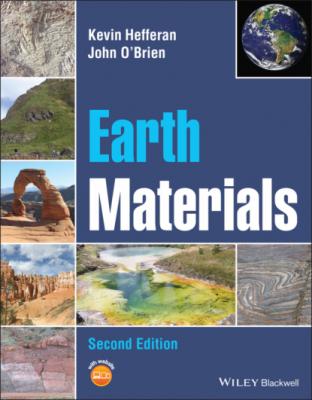Earth Materials. John O'Brien
Читать онлайн.| Название | Earth Materials |
|---|---|
| Автор произведения | John O'Brien |
| Жанр | География |
| Серия | |
| Издательство | География |
| Год выпуска | 0 |
| isbn | 9781119512219 |
3.2 PHASE STABILITY (EQUILIBRIUM) DIAGRAMS
The behavior of materials in Earth systems can be modelled using thermodynamic calculations and/or empirical results from laboratory investigations. The results of such calculations and/or investigations are commonly summarized on phase stability diagrams. A phase is a mechanically separable part of the system. Phase stability (equilibrium) diagrams display the stability fields (conditions under which a phase is stable) for various phases in a system of specified composition. These fields are separated by phase stability boundary lines that represent the conditions under which phase changes from one phase to another occur. Phase stability diagrams related to igneous systems and processes summarize relationships between liquids (melts) and solids (crystals) in a system. Such diagrams usually have temperature increasing upward on the vertical axis and composition shown on the horizontal axis. At high temperatures the system is completely melted. The stability field for 100% liquid is separated from the remainder of the phase diagram by a phase boundary line called the liquidus that represents the temperature above which the system exists as 100% melt and below which it contains some crystals. The low temperature stability field for 100% solid crystals is separated from higher temperature conditions by a phase boundary line called the solidus. At intermediate temperatures between the solidus and liquidus, the system consists of two types of stable phases in equilibrium, both liquid and solid crystals. Phase equilibrium diagrams, based on both theoretical and laboratory analyses, exist for a variety of multicomponent systems. A one‐component and five representative two‐component systems related to the discussion of igneous rocks and processes (Chapters 7–10) are discussed below. Metamorphic phase diagrams are discussed in Chapter 18. For discussions of systems that are beyond the scope of this text, including three‐ and four‐component systems, the reader is referred to mineralogy books by Wenk and Bulakh (2016), Nesse (2016), Dyer et al. (2008) and Klein and Dutrow (2007) and to petrology books by Frost and Frost (2019), Philpotts and Ague (2009), Winter (2009) and Best (2000). Some of the more important terms you will encounter in this discussion are defined in Table 3.1.
Table 3.1 A list of some common terms used in discussing phase diagrams.
| Terms | Definitions |
|---|---|
| Liquidus | Phase boundary (line) that separates the all‐liquid (melt) stability field from stability fields that contain at least some solids (crystals) |
| Solidus | Phase boundary (line) that separates the all‐solid (crystal) stability field from stability fields that contain at least some liquid (melt) |
| Eutectic | Condition under which liquid (melt) is in equilibrium with two different solids |
| Peritectic | Condition under which a reaction occurs between a pre‐existing solid phase and a liquid (melt) to produce a new solid phase |
| Phase | A mechanically separable part of the system; may be a liquid, gas or solid with a discrete set of mechanical properties and composition |
| Invariant melting | Occurs when melts of the same composition are produced by melting rocks of different initial composition |
| Incongruent melting | Occurs when a solid mineral phase melts to produce a melt and a different mineral with a different composition from the initial mineral |
| Discontinuous reaction | Mineral crystals and melt react to produce a completely different mineral; negligible solid solution exists between the minerals |
| Continuous reaction | Mineral crystals and melt react to continuously and incrementally change the composition of both; requires a mineral solid solution series |
| Solvus | Phase boundary (line) that separates conditions in which complete solid solution occurs within a mineral series from conditions under which solid solution is limited |
3.2.1 The phase rule
The phase rule (Gibbs 1928) governs the number of phases that can coexist in equilibrium in any system and can be written as:
where
P represents the number of phases present in a system. Phases are mechanically separable varieties of matter that can be distinguished from other varieties based on their composition, structure and/or state. Phases in igneous systems include minerals of various compositions, and crystal structures, amorphous solids (glass) and fluids such as liquids or gases. All phases are composed of one or more of the components used to define the composition of the system.
C designates the minimum number of chemical components required to define the phases in the system. These chemical components are usually expressed as proportions of oxides. The most common chemical components in igneous reactions include SiO2, Al2O3, FeO, Fe2O3, MgO, CaO, Na2O, K2O, H2O, and CO2. All phases in the system can be made by combining components in various proportions.
F refers to the number of degrees of freedom or variance. Variance means the number of independent factors that can vary, such as temperature, pressure, and the composition of each phase, without changing the phases that are in equilibrium with one another. We will use the first phase diagram in the next section to show how the phase rule can be applied to understanding phase diagrams. A discussion of the phase rule and of phase diagrams related to metamorphic processes is presented in Chapter 18.
3.2.2 One component phase diagram: silica polymorphs
Pure silica (SiO2) occurs as a number of different mineral phases, each characterized by a different crystal structure. These silica minerals include low quartz (alpha quartz), high quartz (beta quartz),
